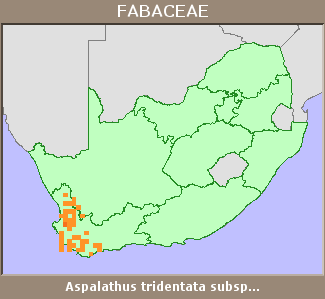|
Scientific Name | Aspalathus tridentata L. subsp. tridentata |
Higher Classification | Dicotyledons |
Family | FABACEAE |
Synonyms | Aspalathus argentea L. b. glabriuscula E.Mey., Aspalathus pilosa L. |
National Status |
Status and Criteria | Least Concern |
Assessment Date | 2009/07/21 |
Assessor(s) | W. Foden & L. Potter |
Justification | Widespread, common and not declining. |
Distribution |
Endemism | South African endemic |
Provincial distribution | Northern Cape, Western Cape |
Range | Cederberg to the Cape Peninsula and eastwards to Swellendam. |
Habitat and Ecology |
Major system | Terrestrial |
Major habitats | Fynbos |
Description | Sandstone fynbos. |
Population |
Population trend | Stable |
Assessment History |
Taxon assessed |
Status and Criteria |
Citation/Red List version | | Aspalathus tridentata L. subsp. tridentata | Least Concern | Raimondo et al. (2009) | |
Bibliography |
Dahlgren, R. 1988. Crotalarieae (Aspalathus). In: O.A. Leistner (ed). Flora of southern Africa 16 Fabaceae, Part 3 Papilionoideae, Fascicle 6:1-430. National Botanical Institute, Pretoria.
Raimondo, D., von Staden, L., Foden, W., Victor, J.E., Helme, N.A., Turner, R.C., Kamundi, D.A. and Manyama, P.A. 2009. Red List of South African Plants. Strelitzia 25. South African National Biodiversity Institute, Pretoria.
|
Citation |
| Foden, W. & Potter, L. 2009. Aspalathus tridentata L. subsp. tridentata. National Assessment: Red List of South African Plants version 2024.1. Accessed on 2025/10/26 |
 Comment on this assessment
Comment on this assessment


